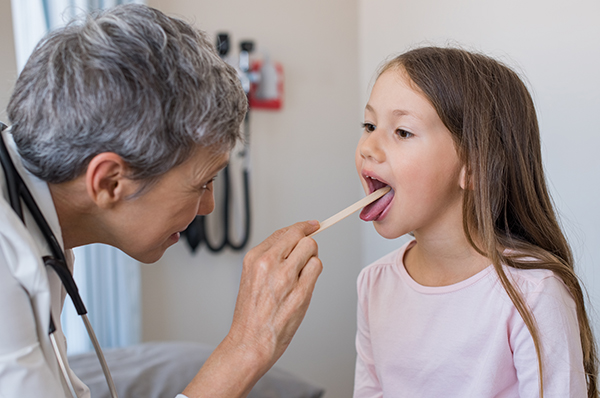Every year about half a million children undergo surgery to remove the tonsils or adenoids—or both.
So don’t be surprised if your child joins the club.
The tonsils, located at the back of the mouth, and the adenoids, located at the back of the nose, help guard the body against infections entering through the mouth or nose. But they can get infected themselves and swell, blocking the airway, affecting the quality of your child’s sleep or—in the case of adenoids—causing recurrent ear or sinus infections.
Removing the tonsils or adenoids is a fairly simple procedure, said Dr. Drew Prosser, a pediatric ear, nose and throat specialist at the Children’s Hospital of Georgia.
“Parents tend to have more questions about the anesthesia, but the benefit of having surgery at a children’s hospital is that your child will be cared for by a pediatric anesthesiologist specifically trained to take care of kids—and only kids,” said Dr. Prosser. “The surgery itself takes about 15 to 20 minutes, and the total time a child is away from his or her parents is only about an hour. Kids typically go home the same day, although we may keep children younger than 3 or who have severe sleep apnea overnight for monitoring.”
It’s the recovery that can be a little tougher. From throat pain and bleeding to “whoa, what’s going on with my child’s breath?”, here’s everything you need to know about recovery after tonsil/adenoid surgery—but didn’t necessarily know to ask.
So how bad will my child’s throat hurt?
Some kids bounce back after just a few days; others can experience a sore throat for about two weeks, said Dr. Prosser: “It’s really varied. But you want to stay on top of the pain and not wait until your child complains to control it.”
Your doctor will typically prescribe alternate doses of acetaminophen and ibuprofen, taken every three to four hours for at least three days. Some of us may remember taking Tylenol with codeine after tonsil surgery, but that’s no longer advised since it’s been shown that codeine can increase the risk of breathing complications after the surgery.
What can my child eat after surgery?
Whatever he or she wants! According to Dr. Prosser, no studies show that soft foods reduce throat pain or speed recovery. So let your child be the special guest and order whatever he or she likes best from chef mom or dad for at least a week or so. Remember, for most kids, cool and soothing popsicles and ice cream are mandatory!
However, what your child eats is less important than the fact that your child drinks plenty of fluids. “Good hydration can have a big impact on reducing pain. Even though it might hurt to drink at first, if your child’s throat becomes dry, it will hurt more. So encourage your child to drink whatever his favorite drink is, whether that’s water or Powerade or even soda,” said Dr. Prosser.
My child has some blood in his/her mouth. Should I be worried?
Probably not, but you should still tell your doctor. “It’s not uncommon to see a small amount of bleeding when scabs fall off about a week after surgery,” said Dr. Prosser. However, it’s important to call your doctor if you see any bleeding at all: “Since bleeding is a possible complication of surgery, we like to be very vigilant.”
Also make sure to call your doctor if your child experiences any fever after surgery, worsening pain or if your child doesn’t want to eat or drink.
My child is complaining about ear pain. What’s going on?
Some children may experience the sensation of ear pain after surgery. This is known as “referred pain.” The pain technically is still in the throat, but because a nerve runs next to the tonsils up to the ear, irritation around the tonsil area can cause the nerve to create the feeling of ear pain. Just continue to treat your child with acetaminophen and ibuprofen as prescribed.
Should my child be getting antibiotics?
There’s no need for your child to take antibiotics after tonsil/adenoid surgery. Studies have shown that taking antibiotics doesn’t decrease the risk of infections after surgery, but it can increase the likelihood of antibiotic allergy or resistance. However, if your child gets a fever or shows other signs of infection, that’s when you can expect your doctor to prescribe antibiotics.
My child has weird white patches in the back of his/her throat. Is this normal?
Think about it: When you have a sore in your mouth, what color is it? In the mouth and throat, scabs don’t show up as dark brown as they do on the skin; instead, they tend to be smooth and white. So yes, they are totally normal! However, if you see redness or bleeding, make sure to check with your doctor.
Help! My child’s breath is absolutely horrible after surgery.
Bad breath is a normal—but for parents, a totally unexpected—side effect of tonsil/adenoid surgery. The smell, unfortunately, is just part of the healing process. So just go with it, and the breath should go back to its usual freshness once your child’s throat heals. Just don’t try to use mouthwash or other rinses to clear it up—that will only aggravate your child’s throat and will definitely cause increased pain.
My child’s voice sounds different now after surgery—what happened?
This phenomenon is known as velopharyngeal insufficiency, or VPI. What happens is that when tonsils or adenoids are swollen, they can press against your child’s palate, trapping the muscle so that it doesn’t work as well. But after those swollen tissues are removed, your child’s palate needs time to learn how to work properly again. As a result, this can alter your child’s speech and even allow food or water go up the nose from the back of the throat. But, note that this phenomenon is very rare and usually goes away on its own. If your child is still having problems six weeks after surgery, a speech therapist can work with your child and provide exercises to strengthen the muscle.
Any other tips on how I can help my child be more comfortable?
“One of the best things you can do is invest in a humidifier if you don’t already have one,” said Dr. Prosser. “It’s a great addition to your child’s bedroom since the mist will help your child’s throat stay moist at night. Just make sure to clean the humidifier daily according to manufacturers’ instructions. Plenty of hugs and play time while your child is recovering also helps!”




